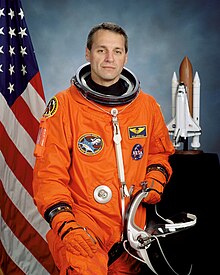

Richard Linnehan
| |
|---|---|
 | |
| Born | Richard Michael Linnehan (1957-09-19) September 19, 1957 (age 66)
Lowell, Massachusetts, U.S.
|
| Education | University of New Hampshire (BS) Ohio State University (DVM) Harvard University (MPA) |
| Awards | NASA Distinguished Service Medal |
| Space career | |
| NASA astronaut | |
| Rank | Captain, USA |
Time in space | 59d 20h 49m |
| Selection | NASA Group 14 (1992) |
Total EVAs | 6 |
Total EVA time | 42h 11m[1] |
| Missions | STS-78 STS-90 STS-109 STS-123 |
Mission insignia | |
Richard Michael Linnehan (born September 19, 1957) is a United States Army veterinarian and a NASA astronaut.
Linnehan was born September 19, 1957, in Lowell, Massachusetts, and was raised by his paternal grandparents, Henry and Mae Linnehan. He grew up in the state of New Hampshire. He is single and enjoys various sports, outdoor activities and natural history.
After graduating from The Ohio State University College of Veterinary Medicine in June 1985, Linnehan entered private veterinary practice and was later accepted to a two-year joint internship in zoo animal medicine and comparative pathology at the Baltimore Zoo and Johns Hopkins University. After completing his internship, Linnehan was commissioned as a captain in the U.S. Army Veterinary Corps and reported for duty in early 1989 at the Naval Ocean Systems Center, San Diego, California, as chief clinical veterinarian for the U.S. Navy’s Marine Mammal Program. During his assignment at the Naval Ocean Systems Center, Linnehan initiated and supervised research in the areas of cetacean and pinniped anesthesia, orthopedics, drug pharmacokinetics and reproduction in direct support of U.S. Navy mobile marine mammal systems stationed in California, Florida, and Hawaii.
Selected by NASA in March 1992, Linnehan reported to the Johnson Space Center in August 1992 where he completed one year of astronaut candidate training, qualifying him for Space Shuttle flight assignments as a mission specialist. Linnehan was initially assigned to flight software verification in the Shuttle Avionics Integration Laboratory (SAIL). He was subsequently assigned to the Astronaut Office Mission Development Branch, working on payload development, and mission development flight support for future Space Shuttle missions. He first flew as a mission specialist in 1996 on STS-78, the Life Sciences and Microgravity Spacelab (LMS) mission. In 1998, he served as the payload commander on the STS-90 Neurolab mission. In 2002, he was a member of the four-man EVA crew on STS-109 the fourth Hubble Space Telescope servicing mission. In 2008, he was the lead spacewalker on [(STS-123)] 1JA, an ISS assembly mission where he performed three EVAs and supervised the remaining two during the installation of the JEM module and Canadian SPDM. A veteran of four space flights, Linnehan has logged over 59 days in space, including six EVAs (spacewalks) totaling 42 hours and 11 minutes.[1]
As of 2020, Linnehan is a management astronaut and no longer eligible for NASA Space flight assignments. Dr. Linnehan splits his time between the Astronaut Office Exploration and Integration branches and the NASA Institutional Review Board (IRB) and JSC Institutional, and NASA Flight, Animal Care and Use Committees (IACUCs).[1]
STS-78 LMS (June 20 to July 7, 1996). The Life Sciences and Microgravity Spacelab mission was flown aboard Space Shuttle Columbia. The 17-day flight included studies sponsored by ten nations and five space agencies, and was the first mission to combine both a full microgravity studies agenda and a comprehensive life sciences payload. STS-78 orbited the Earth 271 times, and covered 7,000,000 miles (11,000,000 km) in 405 hours and 48 minutes.
STS-90 Neurolab (April 17 to May 3, 1998) was Linnehan's second Spacelab mission. During the 16-day flight the seven-person crew aboard Space Shuttle Columbia served as both experimental subjects and operators for 26 individual life science experiments focusing on the effects of microgravity on the brain and nervous system. STS-90 orbited the Earth 256 times, and covered 6,300,000 miles (10,100,000 km) in 381 hours and 50 minutes. Both missions served as a model for future life sciences studies on board the International Space Station.
STS-109 HST Servicing Mission 3B (March 1 to March 12, 2002) was the fourth Hubble Space Telescope (HST) servicing mission and Linnehan's third flight aboard Columbia. The crew of STS-109 successfully upgraded the Hubble Space Telescope's systems over the course of five consecutive EVAs, leaving it with a new power control unit, improved solar arrays, the new Advanced Camera for Surveys (ACS), and an experimental refrigeration unit for cooling the dormant Near Infrared Camera and Multi-Object Spectrometer (NICMOS). With his teammate John Grunsfeld, Linnehan performed three of the five spacewalks totaling 21 hours and 9 minutes. STS-109 orbited the Earth 165 times and covered 3,900,000 miles (6,300,000 km) in just over 262 hours.
STS-123 (March 11 to March 26, 2008) was Linnehan's fourth spaceflight, and his first aboard the Space Shuttle Endeavour. The mission delivered the Japanese Logistics Module and the Canadian Special Purpose Dexterous Manipulator to the International Space Station. Linnehan performed three of the five scheduled spacewalks on STS-123 with Garrett Reisman, Mike Foreman and Bob Behnken.
|
| |||||||
|---|---|---|---|---|---|---|---|
NASA Astronaut Group 13 ← NASA Astronaut Group 14 → NASA Astronaut Group 15 | |||||||
| Pilots |
| ||||||
| Mission specialists |
| ||||||
| International mission specialists |
| ||||||
| |||||||